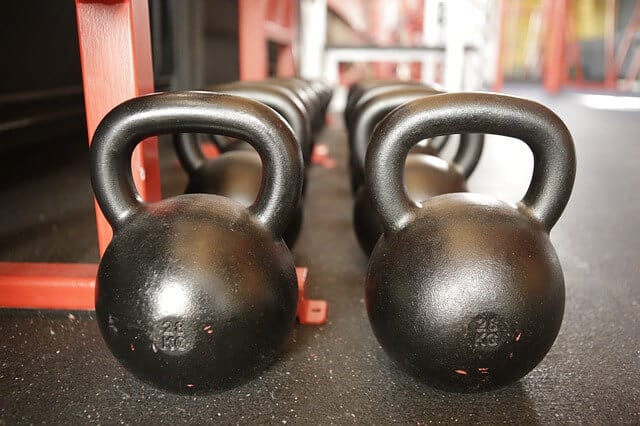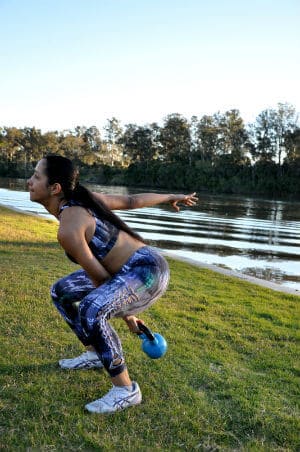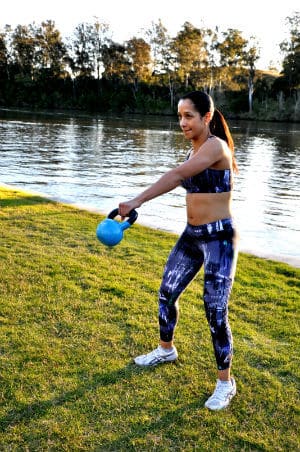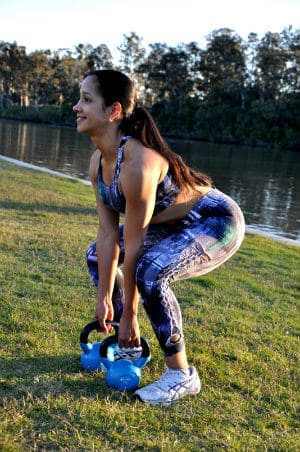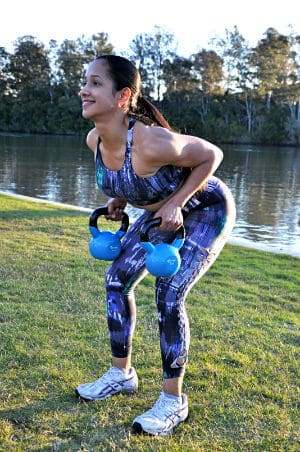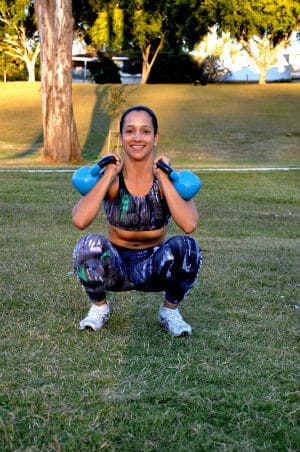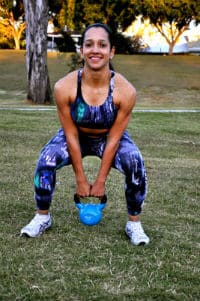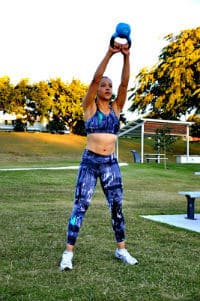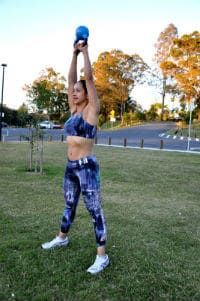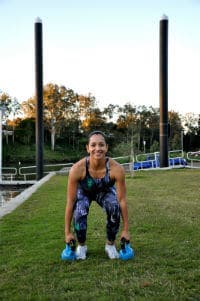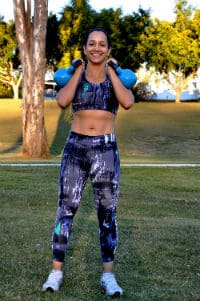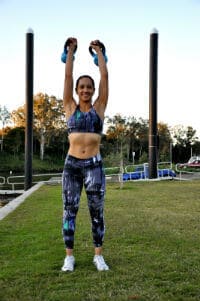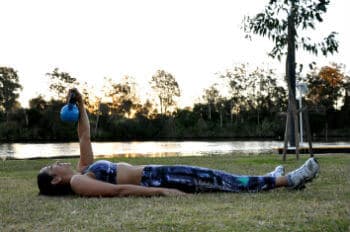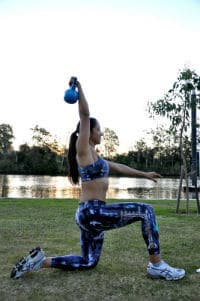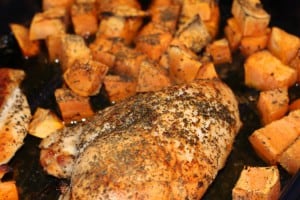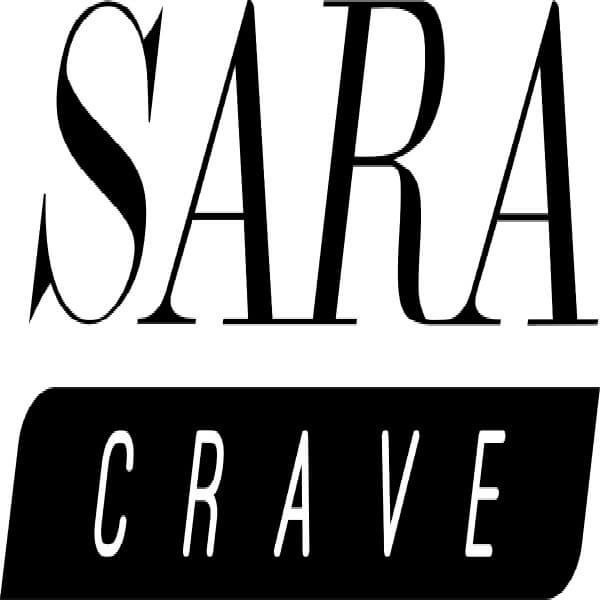- in Fitness Training by Ana Maria
- |
- 2 comments

Kettlebell workout routine for a full body blast
Kettlebell workout routine that will give you amazing toning benefits, with kettlebell exercises for the whole body.
Designed to sculpt your body, these awesome kettlebell exercises are also a great way to introduce some fun into your training routine.
Training in the gym all the time can get boring, so take it outside with a kettlebell workout routine!
Kettlebell Workout Routine
**This is only an example exercise routine, and is not providing any specific advice to any person. As with any new exercise activity, you should check with your own medical and health professionals for advice on your own personal condition prior to commencing any new activity
Exercise | Reps | Rest | Sets |
|---|---|---|---|
kettlebell swings | 20 | 15 seconds | x 4 |
double kettlebell bent over row | 30 | 15 seconds | x 4 |
kettlebell front sqaut | 30 | 15 seconds | x 4 |
kettlebell double snatch | 20 | 15 seconds | x 4 |
kettlebell double clean and jerk | 20 | 15 seconds | x 4 |
kettlebell Turkish get up | 10 | 15 seconds | x 4 |
*Instructions for each kettlebell exercise follow below.
Depending on how much training you've done before, and whether you've ever used kettlebells before, you might find this workout to be a bit challenging.
If that's you, then just double the rest between sets to 30 seconds, and cut back on the amount of sets you do to say three instead of four. But try to at least some sets of each exercise, so you get the benefit of a whole body workout.
But it you'be been training for a while and are in good shape, you might want to add some ab exercises in between sets, or following your kettlebell workout routine.
Kettlebells as exercise equipment
I came across this strange looking piece of equipment in 2010. I know, lots of people discovered it before me:)
It appeared very crude to me, and I was reluctant to use it for exercises initially. I started with standard squats and lunges where I was focusing for leg training routines.
Then I moved on to start a few 'swinging' moves for my core synergistic muscle groups and after a little while I became familiar with this brilliant piece of equipment. Ever since, I've been recommending kettlebells for an alternate to traditional strength training workouts.
Firstly, there's the advantage of the handle. Women who are lifting a great deal of weight often come across gripping problems. Whether it’s the barbell or the dumbbell, the firmness of your grip will play an important part in how well you can perform an exercise. In the case of kettlebells, the handle does the magic and you don't face any problems due to grip.
Kettlebells are cheap to buy as well. They don't cost as much as fancy 'Aluminum coated' dumbbells so you can always go ahead and buy new one's when you grow out of your old pair!
If you are interested in more information about the history, terminology and rules of kettlebell lifting, you can find that here, and here.
Kettlebell benefits
Then comes the question of using kettlebells for exercises;
Performing kettlebell workouts can be very beneficial for a large number of muscle groups at a given time.
Kettlebells enable you to improve on your core. The core becomes involved when you complete actions that involve 'swinging' the weight. With dumbbells and barbells, swinging actions are usually negative and should be avoided, but with kettle bells, moves like 'Double windmill' will strengthen your mid section.
Your mid section is a very important part of the body. It serves as a bridge between your lower and upper body.
Your bodies ability to engage it's true strength can be limited by the strength of your mid section, but this fact is often forgotten in the world of weight training. Stability and swinging moves can be incorporated using kettle bells to strengthen your core, and you will feel the improvement in your traditional lifts in the gym.
Kettlebells engage your forearms a great deal, as compared to the dumbbell or barbell.
For most exercises, the grip is such that your arm is not in its natural straight line. The classic 'briefcase grip' engages the forearm and the stronger grip causes strengthening of your forearms.
The same holds true for functional strength. A Kettlebell workout routine is great to add raw strength to your armory. Since almost all of the moves are compound moves, anything involving the kettle bells will be a complete body workout.
The best thing about kettlebells is the size of the equipment. You can keep it anywhere; Under the bed, in your closet or just by your bedside table. Since it is a single piece of equipment, it doesn't require much space but this brings us to a problem as well.
Since kettlebells are fixed weight equipment, you'll probably have to upgrade to a heavier one every once in a while. If you keep working out with the same resistance level for an extended period of time, chances are that you'll hit a plateau. So, this is a major down side of kettlebells training and body weight training which needs to be kept into mind.
As mentioned in my post on progressive overload, your muscles need to 'overload' in order to hypertrophy. The same level of resistance, over and over again doesn't overload the muscles as the body becomes accustomed to the same resistance level. In order to progress, you'll need to increase the resistance level somehow.
Kettlebell workout routine versus traditional weight training
A good analogy between 'kettlebell workout routine' and a traditional 'weight training session' would be that of a classic muscle car and a new generation sports car! If you need raw strength, grunt and power without worrying too much about external looks, you go with a muscle car. But if you want a car that performs and has a clean look with exquisite styling, you'll be happy with a new BMW rather than going for a Chevy Impaler! Same logic applies to kettle bells training. You may not achieve the very best muscle isolation with kettle bells but it does wonders with functional strength, core stability, muscle endurance and even flexibility.
The workout routine that follows contains some of the best kettlebell exercises you can do.
As you've no doubt heard before, proper form is the key. Sacrificing form for even a single repetition can end up in an injury that can haunt you for months so always be wary of what you're about to do. Belts and gloves are there for a reason, so use them when it makes sense!
Also, it is best to work out with a spotter even when you're working out with body weight or kettlebells. Your partner can help you with your form and can assist you in performing additional repetitions which are crucial for muscle growth.
Kettlebell exercises
Kettlebell swings
Kettlebell swings may look clumsy, but it is one of the most effective total body exercises you can do with the kettlebell.
It gets your shoulders engaged in particular, not to mention the balancing act of your core to oppose the swinging motion of the kettlebell.
This move will strengthen your lower body as most of the stress is endured in your mid-section and your legs during the 'return swing' of the kettlebell.
- The proper starting point of this move requires you to squat with your feet shoulder width apart.
- The kettlebell is extended downwards and your arm must be placed between your legs. Use the overhand grip for this move.
- Your back must be taut, avoid excessive hunching. This is the starting point of this move.
- Now, swing the kettlebell under the hips and swing it in the opposite direction while raising the upper body.
- Extend the legs and help yourself with the swinging action. The kettlebell should swing back and forth between the distance of your legs and slightly above shoulder height.
The move is similar to Front shoulder raises, but with kettlebells the move is more 'dynamic' and compound engaging your entire body.
Double kettlebell bent over row
This move is similar to the classic single dumb bell row.
The difference is that double kettlebell bent-over rows focuses on both sides (Left and right) simultaneously and the grip is a little different as compared to the conventional dumb bell row.
- For the correct starting position stand with your feet shoulder width apart, knees slightly bent and straight back.
- Squat down from this position and grip two kettlebells like briefcases and return to your starting position with the kettlebells hanging freely, vertically downwards.
- From here lift the kettlebells by bending your elbows, like you would in the class dumb bell row.
- Make sure that you lift both kettlebells simultaneously and bring them towards your ribs.
- The only difference in this move is that due to the changed grip, you may not perform much of a 'swing'; rather, it'll be more of a vertical 'lift'.
The benefit is that this move is a better stressor for the lower back as you're lifting more weight and using both sides of the body simultaneously.
This is a great exercise to consider if you're looking for an alternate to classic single dumbbell rows for the back.
Kettlebell front squat
This is a squatting move which can be executed with the help of a kettlebell.
- To start off, stand with your feet shoulder width apart (or a bit wider).
- Next important thing is how you hold the kettle bells for this particular exercise.
- The kettle bells are to be held right in front of the shoulders whereas the arms should be kept really close to the body for the correct execution of the starting point.
- From here, you need to bend your knees and squat down (The way you do in the classic squat or weighted squats).
- Keep lowering your body, keeping your back straight and bent hips.
- Lower yourself until your butt is as low as it can go, in a full squat (ass to grass). Once you hit this point, elevate your body by extending the knees and hips, standing back up straight.
The kettlebell grip is important as well, hold them as you would hold a barbell in a shoulder press.
Kettlebell double snatch
This is similar to the snatch performed in weight lifting.
The idea is to pick the weight up from ground level and raise it above your head in one quick action.
For this two major moves are required; the squat compounded with shoulder raises.
This is a very useful move for building functional strength but without proper form or care, this move is prone to injuries. Here is the proper form:
- Straddle two kettlebells (Which are placed on the ground) with both hands (Single KB snatch can also be done) and stand with your feet shoulder width apart;
- Squatting down to grasp the kettlebells.
- Your back should be straight and your shoulders shoulder be vertically above the kettlebells.
- Without jerking, pull the kettlesbells off the floor by extending your knees and hips, to stand up straight.
- This initial motion is quickly followed by ballistic upward movement of the shoulder and arms to raise the kettlebells further.
- While the kettlebells reach their maximum height, extend your arms straight above your head and aggressively pull your body right beneath the kettlebells to support their weight.
- During this 'pulling the body underneath the kettlebells, you should go into a squat to 'catch' the kettle bell without any impact.
- Once the kettle bells are stably held over your head, extend hips and knees to come out of the 'cushioning' squat and stand straight holding the kettlebells straight over your head.
This is the first repetition, lower the kettlebells back to the floor by doing a partial shoulder press followed by a smooth dead lift and repeat!
Kettlebell double clean and jerk
This is similar to the clean and jerk performed in weight lifting.
If you've already performed the kettlebell snatch, this will become pretty easy.
The moves are quite similar and the idea is to pick the weight up from ground level and raise it above your head in two quick actions.
For this two major moves are required; the squat compounded with shoulder raises, with a little pause in between (Unlike snatch).
This is a very useful move for building functional strength but without proper form or care, this move is prone to injuries.
Here is the proper form:
- Start with 'Clean'. Straddle two kettlebells (Which are placed on the ground with both hands) and stand with your feet shoulder width apart;
- Squatting down to grasp the kettlebells.
- Your back should be straight and your shoulders shoulder be vertically above the kettlebells.
- Without jerking, pull the kettlebell off the floor by extending your knees and hips.
- This initial motion is quickly followed by folding of the elbows and brings your arms beneath the kettlebells to support their weight. This is the 'Clean'.
- Now rest briefly with your shoulders and arms supporting the weight of the kettlebells.
- Continue with the 'Jerk'; continue with a ballistic upward movement driven by the legs and supported by shoulder and arms to raise the kettlebells further.
- Extend your arms straight above your head and aggressively pull your body right beneath the kettlebells to support their weight.
- Once the kettlebells are stably held over your head, stand straight holding the kettlebells straight over your head.
This is the first repetition, lower the kettlebells back to the floor by doing a partial shoulder press followed by a smooth dead lift and repeat.
Kettlebell Turkish get up
The Turkish get up; they don't make exercises any weirder than this!
Well the goal is to lay down with a raised kettlebell and then lift your whole body into an upright standing stance.
For this, your body transitions into many different postures and for this reason it is a total body workout.
There are many different variations of the kettlebell Turkish get up but with this version, we'll be starting while lying on the ground.
- For the starting position, lay down on the floor, fold your right knee and abduct your left leg slightly away from your body.
- Hold the KB in your right hand and raise it vertically above your right shoulder.
- Your left arm should be placed comfortably on the floor.
- From here, while keeping your right arm raised, crunch towards your left elbow, shifting your bodyweight to your left elbow and raising the right side of your body.
- Also use your folded right leg to power yourself to the left side.
- Now, shift your bodyweight to the left hand, keeping your chest up and out.
- From here it's time to get your butt off the floor!
- From the hand supportive position, drive your body into a high bridge.
- The key to this position is to really squeeze your right side glutes, keep your chest out and position your body in such a way that you turn into a tripod with your bodyweight being supported by your feet an left hand while your right hand is still extended vertically upwards.
- Now sweep your left leg and position your left knee on the ground, try to get up into a lunge position with your left knee supporting the weight of your body, right knee folded at 90 degrees, left arm hanging freely and right arm holding the kettlebell.
- Now, one simple lunging move and you're standing up straight!
Let's not forget that you've performed only 1 repetition. Let's repeat the whole thing in reverse for more!
Kettlebell workout routine wrap up
I hope that if you haven't tried kettlebell workout routines before, that you will now, as I'm sure you'll find it fun and will feel the benefits.
It will change your training, and reshape your body.
If you'd like to try more kettlebell routines and learn more about training with them, then I recommend that you check out Greg Brooks site. His Complete Guide to Kettlebell Workouts for Women will give you instructions on a few more different kettlebell exercises and some further examples of kettlebell workout routines that are really good.
And if all this throwing around of kettlebells is just making you hungry, that ok. Good nutrition is a must for anyone who wants to maintain good health and shape up, so I'm with you there.
Try one of these easy clean eating recipes, guaranteed to fix a hungry tummy, with no added fat:)
Garlic chicken roasted sweet potato
I'd love to hear about anyone else's experiences training with kettlebells, because it's always great to get different perspectives and keep learning, so leave a comment bellow, and let me know how you like to use kettlebells in your own workout routines.

